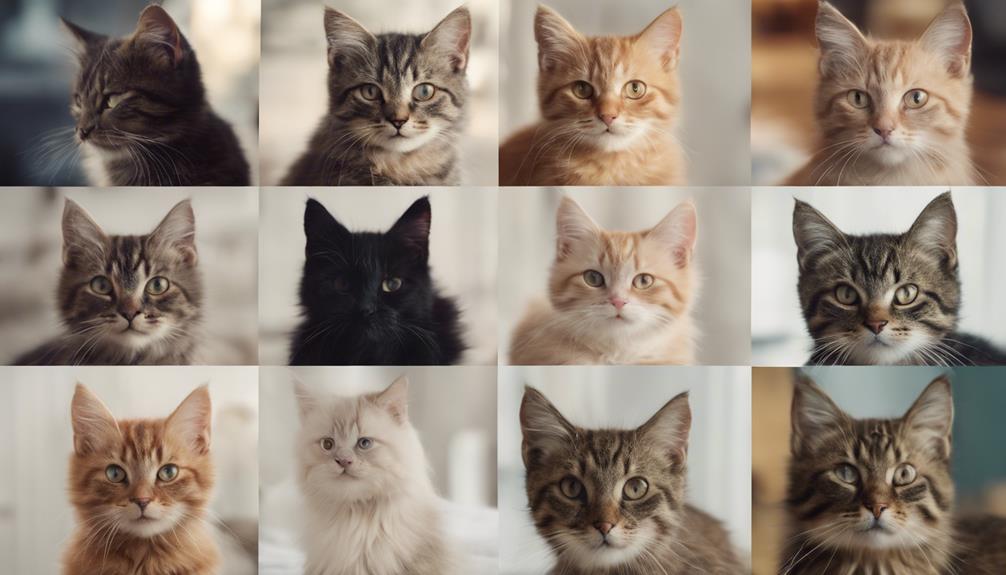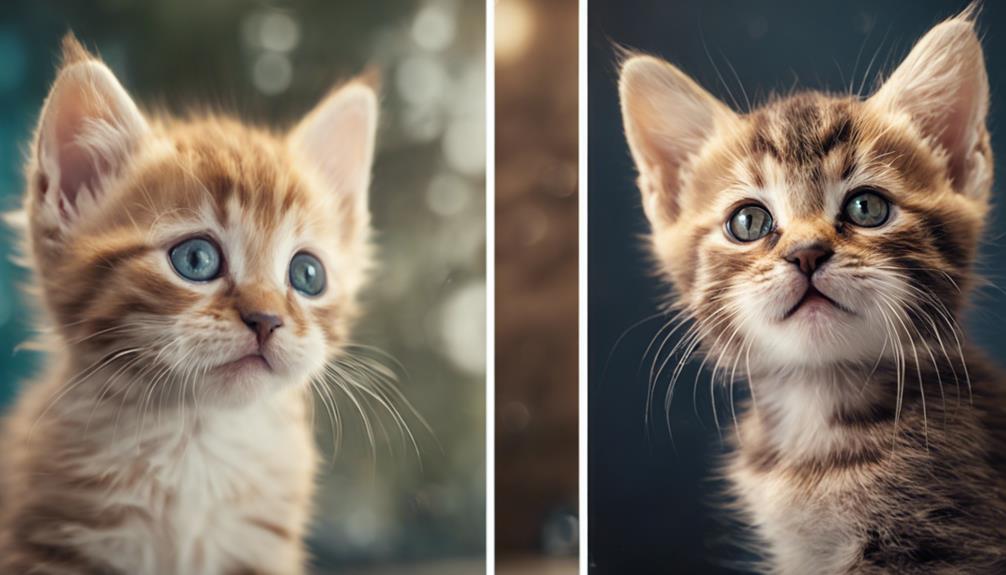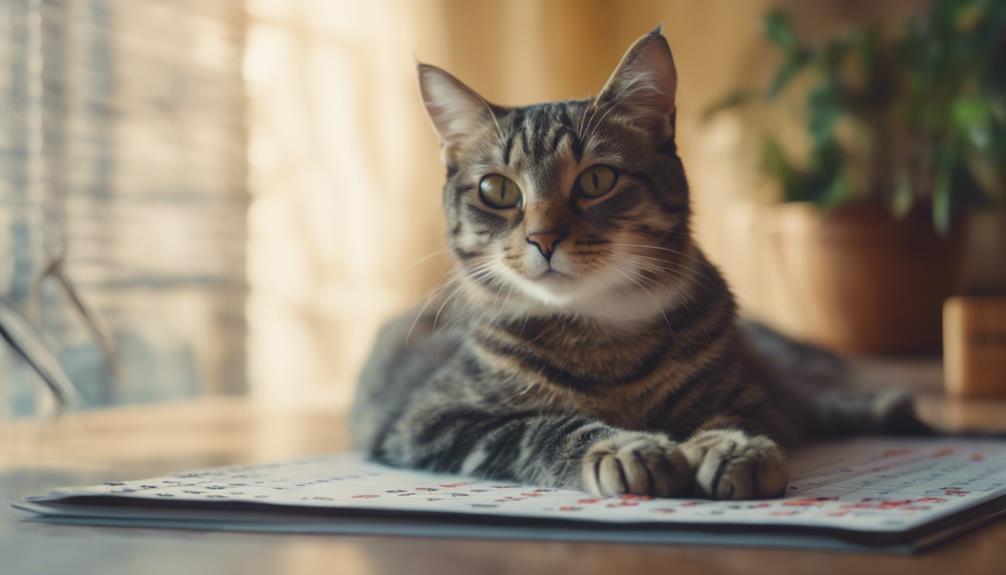Understanding the true age equivalence of your cat in human years is a matter that requires precision and insight.
While many may attempt a simplistic approach to this calculation, the intricacies of feline aging demand a more nuanced understanding.
By exploring the methodology behind determining your cat's age in human years, a deeper appreciation for their life stages and overall well-being can be achieved.
This article will reveal the real way to calculate your cat's age, shedding light on the complexities that shape our understanding of their growth and development.
Key Takeaways
- Cats age faster than humans, with a 1-year-old cat equivalent to a 15-year-old human.
- Cat age conversion is consistent, with each cat year approximately equal to 4 human years.
- Understanding cat age stages helps in recognizing their development and behavior changes.
- Factors like heredity, environment, and nutrition influence a cat's longevity and senior years.
Understanding Cat Aging Process
The feline aging process is a gradual transition marked by distinct stages from kittenhood to senior years, each reflecting significant milestones in a cat's development.
Kittens, in their first year, exhibit the exuberance of terrible twos and the rebelliousness of teenage years. As they transition into young adulthood shortly before turning one, teenage behaviors may emerge a few months after the first birthday. By the age of one, cats are considered young adults, having completed their physical development.
Mental maturity catches up after the second year, marking the beginning of the adult phase. Cats enter their senior years around their 11th birthday, equivalent to humans in their 60s. Factors such as heredity, environment, and nutrition play vital roles in determining a cat's longevity.
Cat Age Conversion Chart
A comprehensive Cat Age Conversion Chart simplifies the process of determining a cat's equivalent human age at various stages of their life. This chart serves as a handy tool for cat owners wanting to understand their feline companion's development in human terms.
For instance, a 1-year-old cat is akin to a 15-year-old human, while a 2-year-old cat is comparable to a 25-year-old. As cats age, each additional year is roughly equivalent to four human years: a 3-year-old cat is around 29 in human years, a 4-year-old cat is like a 33-year-old, and so forth.
Key Cat Age Stages

Understanding the developmental milestones of cats is crucial for providing appropriate care and support throughout their different life stages. Cats progress through various age stages, each with its distinct characteristics and care requirements. Below is a breakdown of the key cat age stages:
| Age Stage | Description | Milestones and Care Tips |
|---|---|---|
| Kittens | Equivalent to the terrible twos and teenage years combined. | Ensure proper nutrition, socialization, and veterinary care. |
| Teenagers | Transition into young adulthood before turning 1, with teenage behavior. | Provide mental stimulation, playtime, and spaying/neutering. |
| Adults | Reach young adulthood at 1 year, complete physical development. | Monitor weight, dental health, and annual check-ups. |
| Seniors | Enter the senior stage around the 11th birthday, akin to human age in the 60s. | Regular veterinary visits, tailored diet, and comfortable environment. |
Understanding these stages will help you provide the best care for your feline companion at every phase of their life.
Importance of Cat Age Calculator
Transitioning seamlessly between cat age stages, the Cat Age Calculator serves as a valuable tool for accurately determining your feline companion's human equivalent age.
- Provides clarity and precision in understanding your cat's age in human terms.
- Helps tailor appropriate care and nutrition based on the cat's life stage.
- Enables better communication with veterinarians regarding age-related health concerns.
Essential Kitten Care Guide

To effectively ensure the well-being of your newly adopted kitten, a comprehensive understanding of essential care practices is paramount. When bringing a kitten into your home, provide a warm and safe environment, complete with a cozy bed, nutritious food, fresh water, and stimulating toys.
Regular veterinary check-ups, vaccinations, and parasite prevention are crucial for maintaining your kitten's health. Proper grooming, litter box training, and socialization play key roles in fostering a happy and well-adjusted feline companion.
Be mindful of your kitten's growth milestones and nutritional needs to support their development into a healthy adult cat. By prioritizing these essential care practices, you can lay a solid foundation for a long and joyful relationship with your kitten.
Tips for Cat Longevity
For enhancing the longevity of your feline companion, implementing lifestyle practices that prioritize health and safety is essential.
- Regular Veterinary Check-ups: Ensure your cat receives routine check-ups to catch any health issues early.
- Balanced Diet: Provide high-quality cat food and monitor portion sizes to maintain a healthy weight.
- Indoor Environment: Create a safe indoor environment to protect your cat from potential dangers outside.
Factors Influencing Cat Lifespan

Factors that significantly impact the lifespan of a cat include genetics, environment, and overall healthcare practices. Genetics play a crucial role, as certain breeds are predisposed to specific health issues that can affect longevity.
Additionally, the environment in which a cat lives, including exposure to toxins, stress levels, and access to quality food and water, can greatly influence their lifespan. Regular veterinary check-ups, vaccinations, parasite control, and dental care all contribute to a cat's overall health and longevity.
Providing a safe and stimulating environment, along with a balanced diet and proper exercise, can help ensure a cat lives a long and healthy life. By considering these factors, cat owners can actively contribute to their feline companion's well-being and lifespan.
Longest Living Cats in History
The exceptional longevity of certain cats throughout history serves as a testament to the impact of genetics, environment, and healthcare practices on feline lifespan.
- Creme Puff: Officially the oldest cat ever recorded, Creme Puff lived to be 38 years old.
- Granpa Rexs Allen: This Siamese cat held the title for the world's oldest living cat, reaching 34 years.
- Lucy: A mixed-breed cat from Wales, Lucy lived an impressive 39 years, setting a high bar for feline longevity.
These remarkable cats demonstrate the potential for long and healthy lives when provided with optimal care and a nurturing environment.
Conclusion
In summary, unraveling the enigma of cat age equivalence unveils the essence of their life stages. By utilizing a precise cat age conversion chart, one can discern the key milestones in their development.
Understanding the factors influencing their lifespan and implementing essential care practices can pave the way for feline longevity.
Delving into the intricacies of cat aging process enriches our comprehension of their journey from playful kittens to wise seniors.




